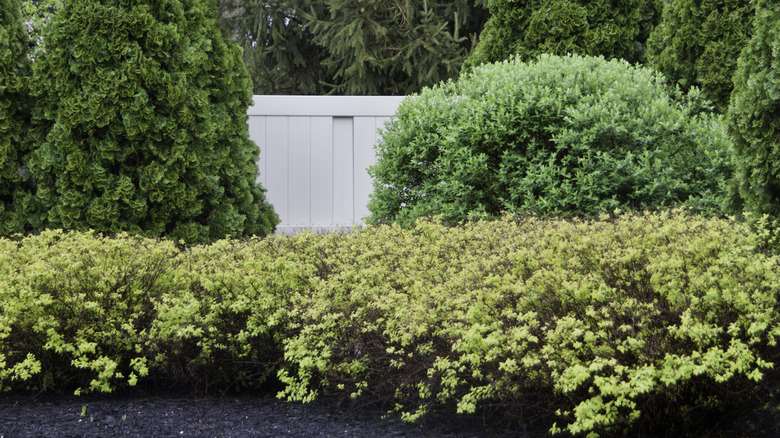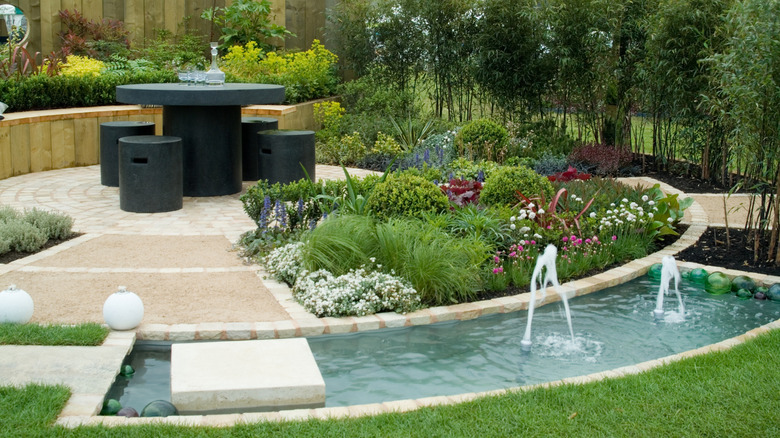How To Soundproof Your Outdoor Living Space For A Quiet Backyard
We may receive a commission on purchases made from links.
It's taken a lot of effort to turn your backyard into an oasis with DIY or professional landscaping. The last thing you want permeating your outdoor sanctuary is neighborhood noise — whether it's the hum of traffic from a busy road, dogs barking, or people having loud conversations next door. There's no limit to the kinds of sounds that can snap you out of a perfectly relaxed state. If you live in a busy neighborhood with lots of ambient noise, you don't have to just deal with it or, worse, move. There are plenty of things you can do to help soundproof your outdoor living space. You can, for example, install soundproofing fencing and features or mask the noise with things that produce more peaceful sounds, like a water feature.
Noise pollution doesn't just disrupt peace and quiet; it can reduce your quality of life and even have a negative impact on your physical and mental health. You may think that sounds absurd, but the consequences of excessive and unwanted noise are real. Prolonged exposure can lead to high blood pressure, increased stress, anxiety, and insomnia. It doesn't matter if you're ready to design your own backyard like the pros do or prefer to work with what you already have. There are all kinds of changes you can make to reduce backyard noise. Bonus: These techniques don't just keep your neighbors from disturbing you. If you like to host outdoor gatherings often, a soundproofed backyard will help keep the noise in, too.
Using a fence to reduce backyard noise
Backyard sunrooms or boxed-in pergolas can block out some neighborhood noise. However, if you want to soundproof your entire backyard, a well-constructed fence is the most effective option. If you don't already have a fence, now is a good time to build one. It will help make your backyard feel more private, too. If you already have a fence, you can update it for better soundproofing. The best noise-reducing materials include masonry (like stone, brick, or concrete), solid wood, vinyl with sound-absorbing inserts, or composite walls. Custom-designed acoustic fencing — sometimes even with smart sound sensors built in — is increasingly popular as suburbs get denser. It's designed for sound absorption, sound deflection, and echo reduction.
To make the most of whatever material you choose, build your fence as high as municipal regulations allow. The higher the fence, the more noise it will block. The walls should be dense with no gaps between planks — any open space will compromise noise-blocking. On a budget or not looking to remodel your entire backyard? You can turn your existing fence into a sound-blocking barrier by purchasing and installing mass-loaded vinyl (MLV) panels. They provide you with some of the protection of a brand new, purpose-built soundproofing fence at lower cost and with less effort. A 4-foot by 25-foot roll of Trademark Soundproofing Mass Loaded Vinyl costs about $260. Outdoor soundproofing blankets you can mount to a fence are another option.
Adding additional soundproofing measures
A well-constructed fence can reduce neighborhood noise, but it likely won't eliminate it. However, there are steps you can take to further soundproof your space and create a more peaceful environment. Add living layers of shrubbery to your fence to absorb sound and strengthen the barrier between you and the source of noise — the denser the better. Installing a moving water feature can mask unwanted sounds with its own calming, consistent sound. Think of it as a natural white noise generator that blocks unwanted sounds while you relax nearby.
Water features are most effective if you place them between the source of the noise and your outdoor living area. Depending on the size of your space, place multiple smaller water fountains around your backyard for maximum impact. If you are looking for a functional design feature that creates a backyard aesthetic worthy of a design or landscaping magazine, add sunken seating to your list of soundproofing features. Building an in-ground seating area that you need to step down into will increase the height of your fences — and make other soundproofing efforts more effective.


